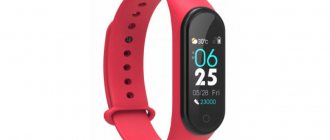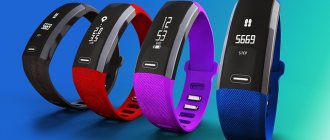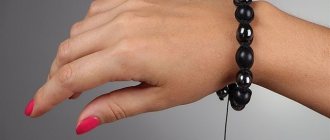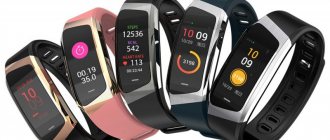Any fitness bracelet is used in different directions.
It allows you to control some parameters of the body, such as heart rate and sleep stages, is used as an alarm clock, and approximately counts calories. But since it takes the place of a watch, it also replaces this accessory.
The gadget displays not only the time, but also the date on the screen, which increases the convenience of its use.
Before you start using the M2, an inexpensive analogue of the Xiaomi Mi Band 2, you need to correctly set the time on the bracelet.
This can be done in various ways, both using third-party programs and directly.
Using the bracelet
Enable/Disable 1) To turn on the bracelet, press and hold the touch key for 3 seconds to turn it on. The bracelet will vibrate and turn on. 2) To turn off the bracelet, press and hold the touch key for 3 seconds to enter the shutdown mode. Press the key once, press and hold your finger on the “Off” icon to turn off the bracelet.
Working with the bracelet 1) When the bracelet is turned on, pressing the touch key once will highlight the screen if the bracelet was in sleep mode, or switch the current mode if the bracelet is in active mode. 2) If the user does not switch bracelet modes or otherwise use it, the screen will turn off after 5 seconds of inactivity. The waiting time before entering sleep mode can be configured via an application on your smartphone. 3) When you enter pulse measurement mode, measurement will start automatically. After exiting the pulse measurement mode, the measurement will automatically stop.
Pin
Also learn how to use the Pedometer step counting device, which is a clip-on device that attaches to your belt. This pedometer can also be ordered from a Chinese online store. They sell it widely on both Joom and Aliexpress. So, read on how to set up a pedometer.
This device has 2 buttons - small and large. The small button is the reset button. By pressing it, you reset the step counter. By pressing the big button, you alternately switch modes:
- Cals - shows the number of calories burned,
- km - distance traveled in km.
- mile — distance in miles.
It turns on automatically when you start moving and starts counting steps. This type of pedometer is placed on the belt. And the accuracy of the calculations depends on the placement
Application features and settings
Personal information Go to the application settings and select “personal information”. Set your photo and indicate your gender, age, height and weight to increase the accuracy of the measurements taken by the bracelet. You can also specify a daily goal, because proper planning is the key to success in achieving sports results.
Notification function Enable the “push messages” function on your smartphone and maintain a constant Bluetooth connection between the bracelet and the smartphone. When you receive a message/notification on your smartphone, the bracelet will vibrate.
Call notifications: when receiving an incoming call, the bracelet will vibrate and display the name of the caller (if he is not recorded in the phone book, the number will be displayed). SMS notifications: when receiving an SMS message, the bracelet will vibrate and display the name of the sender (if he is not recorded in the phone book, the number will be displayed). Smart alarms: with an active connection between the bracelet and the smartphone, you can set up to 3 alarms. After synchronization, the alarm clock will also work in offline mode; vibration will be used for the signal. Warm-up reminder: While connected, if the wearer does not move for a certain time, the band will vibrate to remind you to warm up. The standard interval is 1 hour, you can configure it through the application. Note: Android users: To use the notifications feature, you must allow the app to run in the background.
Other functions
Additional notifications: There are additional types of notifications that are supported only by certain smartphone models. Anti-loss: When the connection is active, the bracelet will vibrate if the distance between the bracelet and the smartphone exceeds the maximum allowable. For Android users, you may need to allow the app to create pop-ups. Bracelet Finder: When actively connected, activating this function will make the bracelet vibrate. Remote Camera: Switch to this mode when the connection is active to control your smartphone's camera remotely. Shake your hand with the bracelet, and the smartphone will take a photo in 3 seconds. Firmware Update: Use to check for updates. The update will require an active connection and approximately 2-3 minutes to download and install the update. During this time, do not allow the connection between the bracelet and the smartphone to be interrupted. Factory Reset: The bracelet and app data will be reset and all settings will be reset to factory settings.
Main conclusions
The M2 fitness bracelet is an analogue of the Xiaomi Mi Band 2 device. It allows you to track the main characteristics of the body, use a smart alarm clock, or simply keep track of the time. The functionality of the gadget is significant, practically no different from the Xiaomi Mi Band 2, and in some respects it even surpasses it.
The setup is done through the special DroiHealth application. You can also use other programs from third-party manufacturers. Through your smartphone you can set the exact time and date, set an alarm and maximize the capabilities of your smart device.
According to doctors and nutritionists, a person must walk a certain number of steps every day. Back in the sixties of the previous century, the Japanese came up with a theory that their number per day should be at least 10,000.
The question arises, how to measure this number of steps taken? For this purpose, a pedometer is used in the modern world. The instructions in Russian will help you figure out how to use it correctly.
Display appearance
Watch mode The Bluetooth icon with a cross indicates that the bracelet is not connected to a smartphone. The Bluetooth wave icon indicates that the bracelet is connected to a smartphone. Once connected, the bracelet synchronizes the time with the time of the smartphone.
Pedometer When the user wears the bracelet on his wrist, it counts the number of steps taken every day and displays the number on the screen. Distance traveled Using the height and number of steps you have indicated through the app, the bracelet will calculate the distance traveled. Calories Using the height and weight indicated through the application, the bracelet will calculate the number of calories burned. Pulse measurement To start measuring, you need to switch the bracelet to heart rate monitor mode. Before starting the measurement, the result of the last measurement will be displayed on the screen. If there is no heart rate measurement data in the memory of the bracelet and smartphone, the “-” sign will be displayed on the screen. Measuring Pressure To start measuring, you need to switch the bracelet to the appropriate mode. Before starting the measurement, the result of the last measurement will be displayed on the screen. If there is no pressure measurement data in the memory of the bracelet and smartphone, the “-” sign will be displayed on the screen. The measurement can be started either through the bracelet or through an application on a smartphone (when the bracelet starts measuring heart rate, the heart icon on the bracelet screen will flash, as well as the LED on the back of the case) Attention: The bracelet sensor must fit tightly and motionlessly to the skin and is not located Under the influence of extraneous light sources, the area of skin to which the sensor is adjacent must be clean; dirt and sweat can negatively affect the accuracy of the measurement. Sleep Monitoring 1. The bracelet automatically switches to sleep monitoring mode at 18:00 and starts measuring sleep indicators such as total sleep duration, number and duration of REM/NREM sleep. 2. You can view sleep monitoring data only through the application on your smartphone after synchronization. On Android smartphones, synchronization occurs automatically; for iOS smartphones, you will need to enter sleep monitoring mode and swipe down on the screen to synchronize the data. Attention: sleep monitoring can only be performed if the bracelet is on your hand.
Summing up
A pedometer is a very functional and useful device that allows you to not only monitor the number of steps taken, but also calories burned, heart rate, and even sleep. And if you are for a healthy lifestyle, then a fitness tracker should become your indispensable assistant.
When choosing a device, pay attention to the manufacturer, durability and build quality, appearance, functionality and battery. Depending on your preferences and budget, choose the most suitable option. And remember that movement is life. Try to move around on foot more, and you will not be familiar with any diseases, excess weight and other problems!
FAQ
1. Why can’t my smartphone detect the bracelet? Make sure that your smartphone has Bluetooth turned on and its system meets the minimum requirements (Android 6.0 or higher, GPS positioning is enabled, the application is given access to determine the location of the smartphone). 2. The bracelet is detected, but cannot be connected. In some smartphone models, situations arise when, due to a system failure or other reason, the smartphone cannot connect the bracelet. To solve this problem, you can try restarting Bluetooth or the smartphone itself. 3. The pedometer periodically stops working. To use this feature, the bracelet must be connected to a smartphone. The established operating algorithm requires you to take approximately 50-80 steps to resume counting after you have stopped. 4. What is a firmware update? Does it make sense to carry it out? The bracelet's firmware is a program that controls the operation of the device, similar to operating systems for computers and smartphones. Updating the firmware can optimize the performance of the bracelet and add new functions. 5. By what principle is heart rate measured? Why does measurement take so long? The principle of light reflection is used to measure pulse. The light produced by the bracelet's sensor is reflected back and read. Since blood absorbs light of a certain wavelength and has a pulsating nature of movement, it can be measured by reflecting light. For this reason, the accuracy and speed of measurements is significantly reduced if light from extraneous sources enters the space between the skin and the sensor. 6. The bracelet does not display the notification function. For iOS system: the first time you connect the bracelet to your smartphone, you must confirm the connection and set up notifications for incoming calls/SMS/QQ/WeChat messages and other notifications in order to receive them in the notification center. For the Android system: when the bracelet is connected to the smartphone, you need to open the notification settings and give the application access to calls and messages, and also add the application to the trusted list. 7. Connection drops frequently (for Android system). The Android system has a power saving feature that periodically disables applications running in the background, which leads to a break in the connection between the bracelet and the smartphone. In order to prevent connection loss, the application must be allowed to run in the background and also be included in the list of trusted ones.
Device Features
The main function of a pedometer, also called a pedometer, is the ability to count the number of steps taken. Initially, such devices were used for the purpose of military and sports training, but today they are actively popular among ordinary citizens.
This device allows you to maintain your health, keep your figure in shape and stabilize your daily activity. A special feature of the pedometer is that in the modern rhythm and living conditions, most people prefer to use transport to get around, while moving very little on foot, which has a detrimental effect on their figure and health. And it is this device that will help take into account the distance traveled, which can become an incentive to travel on foot more often.
Experts have long proven that an adult needs to walk 10 thousand steps a day, which is the norm for physical activity.
Unfortunately, not everyone manages to pass this standard due to lack of free time, energy, or due to a sedentary lifestyle, which our professions often force us to do. Walking is the fastest and easiest way to get rid of excess energy, and a pedometer is just the device that will allow you to accurately control this process.
In addition, the pedometer will be useful for those people who are faced with problems of the cardiac system. The device will help you not to overload your body, so as not to cause any complications or incidents from the cardiac system.
What to do if problems arise
Not everyone can immediately find the right smartphone application. Therefore, you can use the QR code, where the download link is embedded. It is located on the box that contains the M3 fitness tracker. Although, you can try to find the WearFit app yourself.
If the device does not sync with your phone, you need to check that the Bluetooth version is more than 4.0, and the Android version is more than 4.4. If the technical characteristics match, but the problem persists, you should contact the service center.
It is recommended to allow the application to download updates automatically for the fitness tracker. Then the program will always be up to date and will allow the M3 bracelet to work in accordance with the stated requirements, providing accurate data.
Gesture control
It is recommended to wear the bracelet on your left hand. Information is viewed using the “View Time” gesture—raise your hand as if you were wearing a watch and want to see what time it is. You can also simply press the button several times.
Using a smart bracelet, you can control the camera on your smartphone. This function is quite popular, because it allows you to take high-quality photographs without outside help.
Some bracelets have the function of unlocking your smartphone without a password and fingerprints. To do this, you must enter the password from the bracelet once, of course, if the device is equipped with a screen. Next, you should set the distance at which the screen will unlock automatically.
How different pedometers work
Even in the times of Ancient Rome, legionnaires used mechanisms to calculate the distance traveled. For us, these devices seem completely inconvenient and cumbersome. When watchmakers began improving this device, pedometers became more compact and moved into the category of household and sports devices.
Devices for counting steps taken can be divided into three groups:
- Mechanical devices.
- Electronic devices.
- Combined electromechanical devices.
In comparison with samples of past times, when mechanical pedometers were bulky devices, now they are much smaller, but the principle of their operation has not changed. A modern mechanical pedometer is comparable in size to a pocket watch. The operating principle is also similar to the operation of a clock mechanism.
With this design, the pendulum rotates the drive gear by one tooth at any step. This movement, through the transmission mechanism, forces the arrow to move one division.
This is almost a complete analogue of a self-winding watch, only instead of a traditional dial there is a scale with steps. Such a device can give false readings if you wave your hand while remaining in place.
Further development of progress helped to abandon mechanical gears - electronic recording of the movements of the pendulum appeared. The device has become much smaller in size, but the measurement error remains. To obtain accurate results, pendulum pedometers must be secured to a waist belt.
The active introduction of microprocessors into household appliances has radically changed the design and dimensions of the pedometer. The heart of the modern device is an accelerometer (made on a microcircuit), which evaluates acceleration in various directions. Data processing is carried out using specialized programs.
This pedometer correctly counts steps, regardless of location - in your hand, on your belt, in your pocket. The best models can classify the type of activity - whether a person is running or walking.
There are examples whose operation is based on contact sensors that give an impulse when pressed; they are fixed on the sole of the shoe. Since the sensor is placed on one leg, the pedometer counts pairs of steps.
Experts believe that, regardless of the type of device, ideally correct readings can only be obtained if the device is attached to a waist belt.
You need to understand that a pedometer can count steps even if a person is moving in transport, especially if this happens on a bumpy road.











